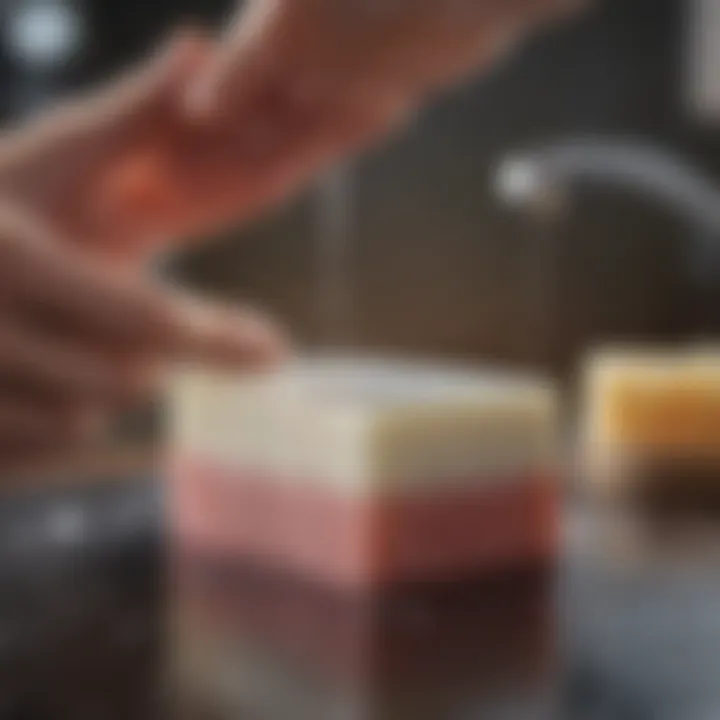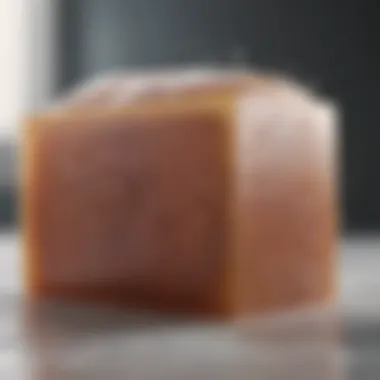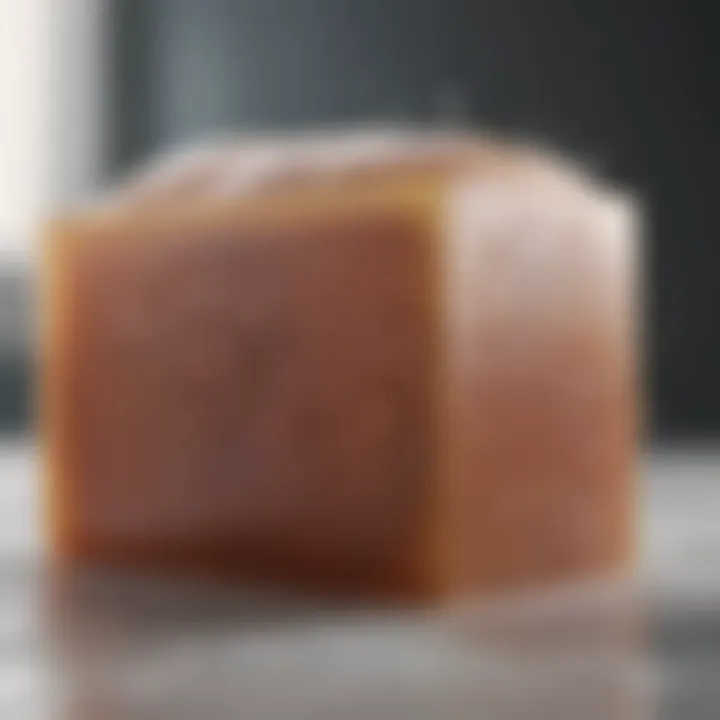Exploring the Science Behind Wound Care Soap


Intro
Wound care soap plays an essential role in the treatment and management of various injuries. Over the years, the significance of using specialized soaps in wound care has grown tremendously. These products are often formulated to not only cleanse wounds but also help in the healing process.
In today’s medical landscape, proper wound care has become pivotal. Traditional methods may offer a foundation, but the integration of modern formulas tailored for specific scenarios is crucial. This article aims to walk readers through the intricacies of wound care soap, including its components, benefits, and the guidelines for effective use.
There’s a world of information out there; let’s dig a bit deeper into what makes these soaps indispensable in medical treatments.
Foreword to Wound Care Soap
When it comes to the intricate web of healing, the discussion around wound care soap holds a pivotal position. Many might take for granted the act of cleansing wounds, but it’s a process rich with significance. Wound care soap does more than simply cleanse; it acts as a facilitator in the journey toward recovery. This article aims to elucidate the various layers surrounding wound care soap—from its formulation to its therapeutic role in healing.
Defining Wound Care Soap
Wound care soap isn’t your typical cleaning agent; it’s a specialized product developed with distinct purposes in mind. At its core, wound care soap combines gentle cleansing properties with therapeutic ingredients that specifically target wound sites. It’s formulated to avoid irritation while effectively removing debris, bacteria, and other contaminants that can impede healing. Unlike ordinary soap that may leave residues, wound care soap often contains surfactants that break down oils and clumps of dirt.
Some examples include chlorhexidine and benzalkonium chloride, which are added for their antimicrobial benefits. Clear labeling often indicates their intended use, allowing for an informed choice tailored to specific needs. Think of it as a gentle sentinel keeping watch over your skin as it mends, fostering an environment where healing can thrive.
Significance in Medical Treatment
The significance of wound care soap stretches far beyond mere cleanliness. In medical treatment, this soap plays a vital role in infection prevention, a key factor in any successful recovery. Infections can arise swiftly if wounds are not managed correctly, leading to complications that could prolong healing times or even result in severe conditions.
"Effectively cleansing a wound is the first step to safeguarding it from infection."
Using wound care soap helps keep the wound environment conducive to healing. When wounds remain clean and free of pathogens, the body can focus its healing responses more effectively. Moreover, healthcare professionals often emphasize the importance of proper wound care protocols, including the use of specialized soaps, to minimize the risk of complications. The right product not only promotes healing but also supports a patient’s overall comfort during the recovery phase. Thus, the choice of soap should not be taken lightly, marking a critical juncture in effective wound management.
Key Ingredients in Wound Care Soap
Wound care soaps are not just about cleaning; they’re about creating a suitable environment for healing. The ingredients that go into these soaps play pivotal roles, affecting both efficacy and safety. Understanding key ingredients helps users appreciate how products can support wound treatment. A range of ingredients combine synergistically to cleanse wounds while reducing infection risks.
Surfactants and Their Role
Surfactants are the backbone of wound care soaps. They lower the surface tension of water, enabling it to spread and penetrate better. This is significant because it means that dirt, debris, and bacteria can be effectively washed away more easily. They work by breaking down the oils and dirt, allowing the soap to lift these impurities off the skin.
When choosing a soap, consider the type of surfactants used. *Anionic surfactants* are effective but may be irritating to sensitive skin. On the other hand, *non-ionic surfactants* tend to be gentler and can maintain skin integrity, which is important for wounds.
Their role doesn't just end at cleaning; they can also help prepare the wound bed, creating a more hospitable environment for healing. In essence, surfactants are your soap's best friends when it comes to effective wound management.
Antimicrobial Agents
Another crucial element in wound care soaps is antimicrobial agents. These ingredients actively work against the growth of pathogens, which is critical for preventing infections. Common antimicrobial agents include *benzalkonium chloride*, *chlorhexidine*, and *iodine-based compounds*.
Each agent has its merits and specific applications; for instance, chlorhexidine is widely used in clinical settings for its broad-spectrum activity. Yet, one must also be wary of its potential for irritation. Hence, it's often wise to read labels carefully and consult professionals when selecting soaps with these agents. This is especially important for open or deep wounds, where infection risk is a high concern.
Furthermore, some soaps combine the antimicrobial properties with skin conditioning agents to ensure that while bacteria are kept at bay, the surrounding skin doesn’t dry out or become compromised.
Moisturizers and Healing Components
Moisturizers are like a balm for healing wounds; they fend off dryness and cracking, which can hinder recovery. Ingredients such as *glycerin*, *aloe vera*, and *hyaluronic acid* help retain moisture and provide hydration to compromised skin.
Incorporating moisturizers into wound care soap is vital because dry skin can lead to discomfort and crack, exposing the wound to additional bacteria. In fact, keeping wounds adequately hydrated can accelerate healing significantly.
These soothing ingredients not only aid in recovery but also promote comfort during the cleaning process, reducing sting and irritation. Some advanced formulations go a step further, integrating growth factors or peptides to enhance the healing process actively.
Ultimately, the combination of these ingredients creates a multifaceted approach to wound cleaning and care, emphasizing the necessity of selecting the right products tailored to individual needs.


Mechanism of Action
Understanding the mechanism of action of wound care soap provides essential insight into its pivotal role in promoting and managing the healing process. This function is not merely about the cleanliness of the skin; it delves deeper into how these soaps are formulated to address the needs of different types of wounds. A thorough grasp of this topic can aid medical professionals, caregivers, and patients in optimizing their wound management strategies, enabling some real progress in healing.
The efficacy of wound care soap largely hinges on its unique components and how they interact within various contexts of wound treatment. These soaps employ a combination of cleansing and antimicrobial actions that are crucial in minimizing infection and facilitating proper healing.
Cleansing Mechanism
The cleansing mechanism inherent in wound care soap serves as the first line of defense against pathogens and debris that could potentially exacerbate a wound. This process is driven primarily by surfactants, which reduce surface tension, allowing the soap to penetrate and lift away dirt, blood, and other unwanted materials from the wound's surface. When used correctly, this cleansing action performs wonders:
- Debridement: It helps to remove the necrotic tissue around the wound, promoting a healthier healing environment.
- Barrier Protection: Clean soothed skin can better fend off bacteria trying to invade the damaged area.
- Moisture Retention: Many soaps also incorporate moisturizing agents, which keep the skin hydrated and aid in the overall healing process.
Regular and gentle cleansing allows for quicker assessments of wound conditions and significantly diminishes risks of infection and complications. Remember, though - excessive washing can irritate the wound, so it's important to strike a balance.
Antimicrobial Properties in Practice
Antimicrobial properties of wound care soaps are not just an afterthought; they are a core part of what sets these products apart from traditional soap. The effectiveness of these soaps in warding off bacteria hinges on their ingredient composition, often featuring a careful blend of antimicrobial agents.
These agents, such as benzalkonium chloride or chlorohexidine, demonstrate significant abilities to reduce bacterial counts. Their role in practice includes the following benefits:
- Prevention of Biofilm Formation: By disrupting the ability of bacteria to adhere and form biofilms on the wound surface, these soaps maintain a lower risk of chronic infection.
- Broad-spectrum Activity: Many modern formulations target a wide range of pathogens, including Gram-positive and Gram-negative bacteria, ensuring a comprehensive defense mechanism.
- Complementing Other Treatments: When used alongside other wound care treatments, the antimicrobial facets of these soaps can enhance overall therapeutic outcomes by decreasing the bacterial burden on the wound.
It’s fascinating to think how a simple cleansing routine can provide a fortress of protection against the microbial threat posed to open wounds. In essence, understanding these mechanisms equips individuals in the field with the knowledge required to select the best products and implement optimal wound care practices.
Comparison with Traditional Wound Care Methods
The realm of wound care is filled with varied methodologies, each with its own merits and drawbacks. Understanding the context in which wound care soap operates against traditional practices offers valuable insights into modern medical approaches.
Historical Context
To fully appreciate how wound care soap shines in today’s medical landscape, it’s essential to look back at the evolution of wound treatment. Traditional treatments included methods like dry gauze dressings, antiseptics, and even leeches in certain cultures. These methods relied heavily on the natural healing processes of the body, sometimes ignoring the microbial dynamics at play.
In centuries past, the ideas around cleanliness and germ theory were not fully developed. Many practitioners used what was available, often leading to infections due to the lack of proper sanitation. Understandably, the introduction of germ theory in the late 19th century revolutionized this field, leading to more conscious efforts toward infection prevention and control. This paved the way for modern wound care practices.
Advantages of Modern Formulations
The shift from old-fashioned methods to innovative formulations, like wound care soap, presents several pivotal advantages:
- Enhanced Antimicrobial Action: Modern wound care soaps are formulated with specific antimicrobial agents that provide a proactive approach to infection prevention. Unlike traditional antiseptics, which can harm healthy tissue, these soaps clean wounds while promoting cell regeneration.
- Moisture Balance: Traditional methods often led to wound drying, delaying healing. Modern soaps promote a balanced environment, which is crucial for effective healing. Maintaining moisture helps in tissue regeneration and reduces scarring significantly.
- Ease of Use: Using wound care soaps simplifies the cleaning process. Their liquid formulations are easier to apply compared to traditional ointments or creams, allowing for better coverage and less mess.
- Targeted Ingredients: Today's soaps include specific ingredients aimed at boosting healing and reducing inflammation. For instance, components like aloe vera or honey might be included to enhance healing properties while being gentle on the tissue.
"Choosing the right product is paramount; it’s not just about cleaning but optimizing the healing journey."
Thus, the comparison between modern wound care soap and traditional methods reveals a significant advancement in understanding wound healing. The focus has shifted from merely cleaning wounds to creating a conducive environment for optimal recovery, illustrating the importance of integrating modern soap formulations into current medical practices.
Guidelines for Effective Use
The proper use of wound care soap plays a vital role in promoting healing and preventing infections. By adhering to a few simple guidelines, one can ensure that wounds are treated effectively, minimizing the risk of complications. It’s crucial to note that not all soaps are created equal; hence, understanding how to choose and apply the right product makes all the difference.
Choosing the Right Product
When it comes to wound care soap, selecting the right product is pivotal. Not every soap on the market offers the same benefits. Here are key considerations when browsing through options:
- Type of Wound: The nature of the wound greatly influences the choice of soap. For instance, surgical wounds might benefit from an antimicrobial soap, while acute wounds may require a gentler formula.
- Ingredients: Look for soaps with minimal irritating chemicals, instead opting for gentle surfactants and effective moisturizers.
- Certification: Always check for certifications from health authorities to ensure that the product meets safety standards.
The expertise one brings to the selection of wound care soap can make a vast difference in outcomes. Being informed is half the battle in wound management, so do your homework, as misuse could lead to serious setbacks like increased pain or infection.
Application Techniques


Once the right product is chosen, mastering application techniques ensures that the soap performs its intended function. Here are several best practices to bear in mind:
- Hand Hygiene: Before even touching the wound, wash your hands thoroughly. Clean hands prevent harmful bacteria from transferring to the wound.
- Sufficient Lather: Applying a generous amount of soap and creating a good lather is essential. This action helps in loosening debris and dirt from the wound site, preparing it for cleaning.
- Gentle Rinsing: Rinse the area with lukewarm water. Avoid using hot or cold water which may shock the tissue. Ensure all soap is thoroughly washed away to prevent irritation.
"Proper application of wound care soap cannot be overstated; it’s the first line of defense against infection and promotes healing."
- Dry Carefully: After rinsing, gently pat the area dry with a clean towel or gauze. Avoid rubbing as this could cause further harm to the sensitive area.
- Follow Up: After cleaning, apply any recommended ointment or dressing as needed to maintain a conducive healing environment.
In summary, effective use of wound care soap isn’t just about choice; it’s also about technique. Knowledge of both can ensure optimal healing conditions.
Understanding Different Types of Wounds
In the context of wound care, it is crucial to understand that not all wounds are created equal. Recognizing the various types of wounds can have profound implications on treatment approaches, particularly when employing specialized products like wound care soap. Each type of wound presents unique challenges and requires tailored strategies for effective healing. In this section, we'll explore the distinctions between various types of wounds and the significance of these classifications in the use of wound care soap.
Acute Wounds
Acute wounds can result from sudden injuries, such as cuts, scrapes, or abrasions. They typically heal within a predictable timeframe, often following a straightforward progression through the stages of healing: hemostasis, inflammation, proliferation, and remodeling. Understanding acute wounds is essential since they often require immediate and effective cleansing to minimize infection risk.
Wound care soap plays a vital role here. Using an appropriate soap helps to remove debris and bacteria while preparing the wound for further treatment. In fact, studies show that wounds treated promptly with effective soaps show improved outcomes, with lower rates of infection and quicker healing times. It's like giving your body a fighting chance right from the get-go.
Chronic Wounds
Chronic wounds, in contrast, are a different kettle of fish. These are typically characterized by a healing process that has stalled, often lasting for weeks or even months. Examples include diabetic ulcers, pressure ulcers, and venous stasis ulcers. The complexities of chronic wounds are numerous, often stemming from underlying health conditions like diabetes or vascular diseases.
For individuals managing chronic wounds, choosing the right wound care soap takes on greater importance. The soap needs to be gentle yet effective, ensuring that it does not irritate fragile skin or disrupt the healing process. An appropriate soap can help maintain a balanced environment that fosters healing, preventing further complications that might arise from improper wound management.
Surgical Wounds
Surgical wounds are a category unto themselves, arising from medical interventions such as operations. While these wounds may be considered acute upon closure, they often require a specific approach due to the risk of infection associated with invasive procedures. The integrity of surgical sites is paramount, and thus, the right choices in wound care, including the use of specialized soaps, become vital.
These soaps can help maintain cleanliness at the incision site, which can be particularly sensitive post-surgery. Not only do they help wash away pathogens, but they also promote comfort for the patient. As surgical techniques evolve and the focus on minimal invasiveness increases, understanding how to care for surgical sites properly remains essential for optimal recovery.
"Proper wound care, including using the right soap, is not merely an act of cleaning; it's an integral part of the healing journey."
In summary, understanding different types of wounds helps to clarify the need for specific wound care protocols. Acute wounds may benefit from prompt cleansing, chronic wounds require gentler and more sustaining care, and surgical wounds must be treated with heightened vigilance. By tailoring wound care practices to the type of wound, practitioners can greatly enhance healing potential and improve patient outcomes.
Safety and Regulatory Considerations
In the realm of wound care, safety and regulatory considerations hold immense significance. With patients’ health on the line, it’s paramount that the products used to support healing meet rigorous standards. This section will explore the necessary safety standards and regulatory compliance that ensure wound care soaps are both effective and safe for public use. Understanding these parameters can aid healthcare professionals, researchers, and students in making informed choices about which products to use or recommend.
Safety Standards in Wound Care Products
When discussing safety standards, we touch upon guidelines and protocols designed to assess whether a product is fit for consumers. Wound care soaps, like any medical device or skin product, are evaluated for their potential side effects, toxicity, and efficacy.
The International Organization for Standardization (ISO) and various national health departments set the framework for these standards. For instance, products must undergo rigorous testing to ensure they minimize the risk of infection, do not cause skin irritation, and maintain their effectiveness under various conditions. Some key safety standards include:
- Biocompatibility Testing: Ensures the soap does not cause adverse reactions upon contact with the skin.
- Microbial Testing: Validates that the soap effectively reduces or eliminates pathogens.
- Stability Testing: Assesses how the product holds up over time, including its shelf life and performance in varying temperatures.
Adhering to these standards not only ensures patient safety, but also instills trust in the end-users. As one healthcare professional summed it up, "If it’s not safe, it’s not worth it."
Regulatory Compliance
Regulatory compliance is another cornerstone in the framework of wound care soaps. The compliance not only denotes conformance to existing safety standards but also encompasses the process through which products are approved for public use. Depending on the country, varying bodies regulate these products. For example:
- In the United States, the Food and Drug Administration (FDA) oversees the approval of medical-related products, including wound care soaps. It categorizes these soaps under medical devices or cosmetics, depending on their intended use and claims made by the manufacturers.
- In the European Union, the European Medicines Agency (EMA) plays a central role, requiring manufacturers to demonstrate compliance with the Regulation on Medical Devices.
Regulatory frameworks are designed to ensure thorough scrutiny of formulations, manufacturing processes, and labeling practices. Companies must keep up with continual monitoring and reporting of product performance post-market. This means they’re not just a ‘one and done’ scenario.


Ultimately, compliance ensures that products on the market have been rigorously vetted. The absence of proper compliance can open the floodgates to ineffective or even dangerous products. This underpins the necessity for ongoing vigilance, not just during initial approval, but as products develop and evolve in the marketplace.
With safety and regulatory compliance in mind, it becomes easier to appreciate the careful crafting of wound care soap products that ultimately contribute to effective healing and patient care.
Clinical Evidence and Studies
In the realm of wound care, having robust clinical evidence is crucial. It provides a foundation for understanding the effectiveness of wound care soap. Without such data, making informed decisions about products and their usage becomes a shot in the dark. This section dives into the significance of clinical evidence, reviews findings from relevant research, and highlights real-world application through case studies.
Research Findings
Clinical studies have been pivotal in illuminating the efficacy of wound care soap. Research typically focuses on parameters such as reducing bacterial load, promoting healing times, and improving patient comfort. For instance, a study published in a peer-reviewed journal found that patients using a specific wound care soap experienced a 30% faster healing rate compared to traditional methods.
Furthermore, meta-analyses combining multiple studies reinforced these findings, suggesting that the ingredients commonly found in wound care soaps, like chlorhexidine and glycerin, have significant antimicrobial benefits. These active compounds not only help in cleaning wounds effectively but also create a barrier that inhibits infection, vital for proper healing.
Another aspect investigated is the soap’s compatibility with various skin types, particularly for patients with sensitive skin conditions. Research indicates carefully formulated soaps can minimize irritation, thus safeguarding delicate areas.
Case Studies
Real-life scenarios provide context to the research findings, showcasing how wound care soap is implemented in clinical settings. One notable case involved a group of post-surgical patients where a new formulation was adopted. The nursing staff noted a dramatic reduction in post-operative infections when this soap was used consistently.
In another instance, a diabetic wound clinic documented improvements in healing outcomes after introducing an antimicrobial soap into their care routine. Patients who previously experienced slow healing due to poor hygiene reported noticeable changes with fewer complications and faster recovery times.
"Clinical evidence not only paves the way for advancements in wound care but also empowers patients and healthcare providers to make informed choices, ensuring the best outcomes."
In summary, it is clear that both research findings and case studies play a critical role in shaping our understanding of wound care soap. They validate its role in modern medical care, offering evidence-based guidance that underlines why choosing the right product is indispensable in wound management.
Innovations in Wound Care
Innovations in wound care have become a cornerstone of modern medical practices, reshaping how healthcare professionals approach the treatment of injuries. This section examines emerging technologies and trends, recognizing how they enhance recovery while improving patient experiences. A key consideration here is the capacity of innovation to create customized solutions that cater to individual healing needs.
Emerging Technologies
The advancement of technology in wound care has led to significant breakthroughs, offering novel strategies for managing wounds. Here are a few notable technologies:
- Bioengineered Skin Substitutes: These products mimic natural skin and can promote healing significantly faster than traditional methods. Patients dealing with chronic wounds often benefit from these innovative solutions as they can reduce recovery time and minimize scarring.
- Smart Bandages: Equipped with sensors, these bandages monitor conditions in real-time, such as moisture levels or signs of infection. They provide valuable data to healthcare providers, allowing for timely intervention.
- 3D Printing: The use of 3D printing technology is revolutionizing the creation of wound dressings and grafts tailored specifically for a patient's wound. Customization means better fit and potentially better healing outcomes.
"Emerging tech in wound care can mean the difference between a lengthy recovery and a swift return to normalcy."
Future Trends
As we look ahead, several trends are likely to influence the future of wound care practices:
- Telehealth Integration: The rise of telemedicine offers patients the chance to receive expert advice without the need to visit a clinic in person. This is especially relevant for monitoring chronic wounds, as patients can send pictures for assessment, allowing for timely adjustments to their treatment plans.
- Artificial Intelligence: AI promises to change how wound assessments are conducted. Algorithms can analyze healing progression and predict potential complications, leading to proactive care strategies before issues become significant.
- Sustainability: There is growing awareness about the environmental impact of medical waste. Innovations aimed at creating sustainable wound care products and packaging are expected to gain traction in the healthcare sector.
The integration of these emerging technologies and future trends signifies that wound care is not static. Instead, it's evolving to meet the greater demands of patient care in an increasingly complex medical landscape.
End
In wrapping up the discussion on wound care soap, it's vital to recognize its crucial role in not just treating wounds, but in facilitating healing processes that are often overlooked. This article has illustrated how wound care soap differs from your standard soap, emphasizing its specialized ingredients and formulations that cater to various wound types.
The benefits of using these soaps in medical treatment extend far beyond basic cleansing. They incorporate active ingredients that help in fighting infections, keeping the wound moist, and promoting faster healing. Moreover, understanding the necessity of these products highlights the importance of informed choices in wound care.
Summary of Key Points
- Formulation and Ingredients: Wound care soaps often contain extra components like surfactants, moisturizers, and antimicrobial agents that are specifically designed to enhance healing.
- Application Guidelines: Knowing how to properly use these soaps can significantly influence the efficacy of the treatment offered.
- Safety and Regulation: Wound care products must meet certain safety standards and regulatory requirements—which helps ensure their efficacy and safety in clinical environments.
- Clinical Evidence: Numerous studies validate the effectiveness of wound care soaps over traditional methods, which often lack the precision of modern formulations.
- Future Innovations: The landscape of wound care is shifting with technological advancements promising more efficient and tailored approaches for different types of wounds.
Final Thoughts
As this discourse on wound care soap draws to a close, it's clear that the evolution of these products is not merely a fad, but a significant stride in medical treatment. The ability of wound care soap to facilitate healing, prevent complications, and enhance the overall quality of care cannot be underestimated.
Opting for the right wound care solution requires a thoughtful understanding of the products available. For students, researchers, and practitioners, staying abreast of these advancements ensures better patient outcomes.
In essence, the emergence of effective wound care soaps marks a transformative change in how wounds are approached. As we continue to expand our understanding, the priority must be on optimizing healing—because after all, that’s what wound care is all about.















